This is THE veggie lo mein recipe that you must have in your rotation of easy meatless meals. You’re going to love how ridiculously easy and quick it is to make. And although it makes two healthy-sized servings (and by healthy I mean substantial), I’m willing to bet you’re going to want to double it.
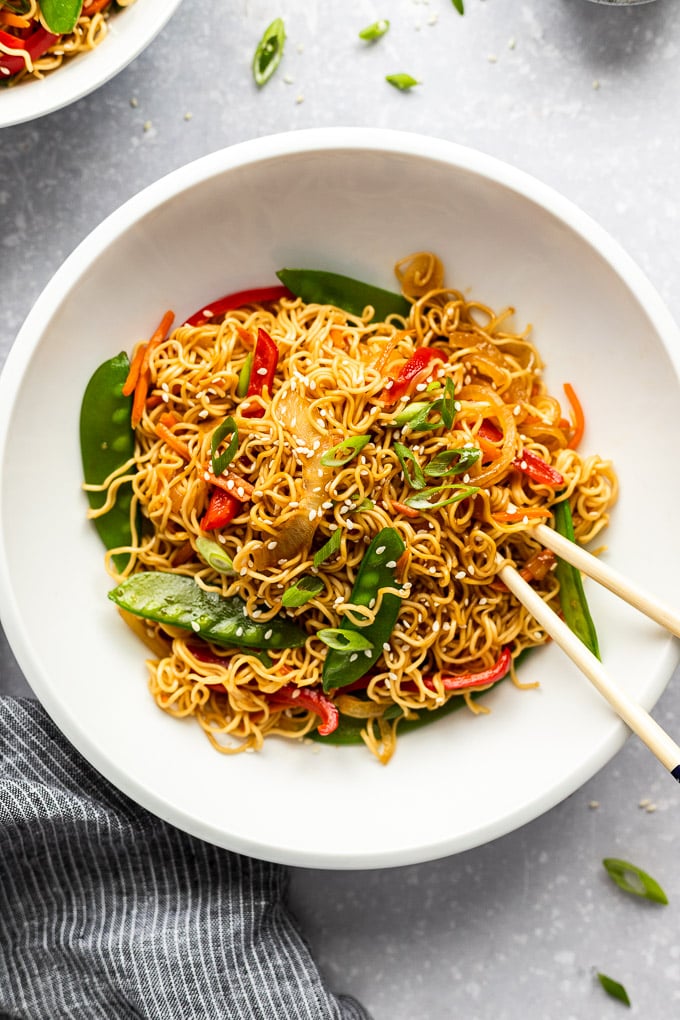
It’s one of those recipes you want to eat the next day for lunch, or breakfast (cold noodles anyone?!), or forevermore, just like this vegetable stir fry recipe or this vegetable pad Thai recipe.
It’s a super flavorful meatless meal (just be sure to see the notes around specific ingredients to make this one vegetarian!). This recipe is Asian-inspired, from a Chinese-American restaurant of my childhood, and is going to be in your weekly repertoire.
Table of Contents
- Lo Mein vs. Chow Mein
- What is Vegetable Lo Mein?
- Ingredients
- Type of Noodles
- Lo Mein Sauce
- How to Cook the Noodles
- Make it Vegan
- Frequently Asked Questions
My lo mein journey starts way back in my junior high days. I lived in a suburb outside of the Twin Cities; it was fairly small at the time but just on the cusp of growing into another metropolitan hot spot.
In those good old days, we had a small, local Chinese restaurant that we would frequently get take-out from or go to for dinner. And they had a lo mein that was the bee’s knees. It was on my must-have list. It was saucy and noodle-y and veggie-tastic.
And the thing was: it had these skinny egg noodles, as opposed to thick ones, and I was in love. This is why this recipe features those same skinny noodles. The ones that won my heart.
Now, since writing this post and experiencing that restaurant’s version of lo mein so many moons ago, I can see how this version of the recipe could be referred to as chow mein as well. The two noodle dishes are often confused with each other, so let’s take a look.
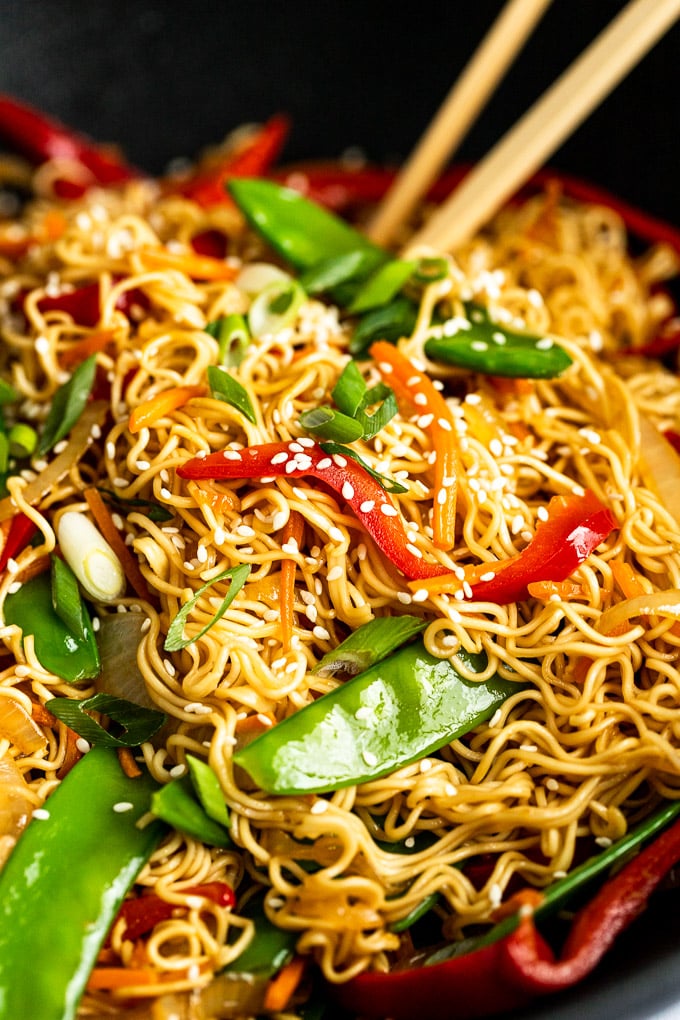
Lo Mein vs. Chow Mein
While it may seem that the difference between lo mein and chow mein is in the type of noodles used, it’s actually in the difference in how the noodles are prepared.
Bee, from Rasa Malaysia, explains that chow mein translates to “stir-fried noodles”, whereas lo mein translates to “tossed noodles”. Both are made from wheat and egg, the difference comes in this cooking process.
Chow mein noodles are parboiled, then finish cooking through a stir-fry process. Chow mein noodles are thinner egg noodles that are the star of the dish. Lo mein noodles are completely cooked in boiling water before getting tossed with the sauce and other ingredients; the noodles are typically thicker to hold up to the saucy consistency of the dish.
Lo mein is all about saucy noodles.
The type of noodles I use do lean more towards the chow mein end of things, however, the other factors in sauciness (it’s a focus!), preparation method (noodles are completely cooked before being tossed with the other ingredients), and that there are a considerable amount of vegetables, lend it to the lo mein side of things.
What is Vegetable Lo Mein?
In short, vegetable lo mein is a Chinese dish made with soft, saucy egg noodles. It typically includes protein, but in this veggie lo mein we are loading up all the vegetables. You can use a mix of your favorite vegetables or any variety of the ones listed here.
Ingredients for Veggie Lo Mein
We have a very straightforward and simple list here, friends. With a few basics you’ll already want to have on hand for a lot of at-home Chinese-inspired recipes, it’s easy!
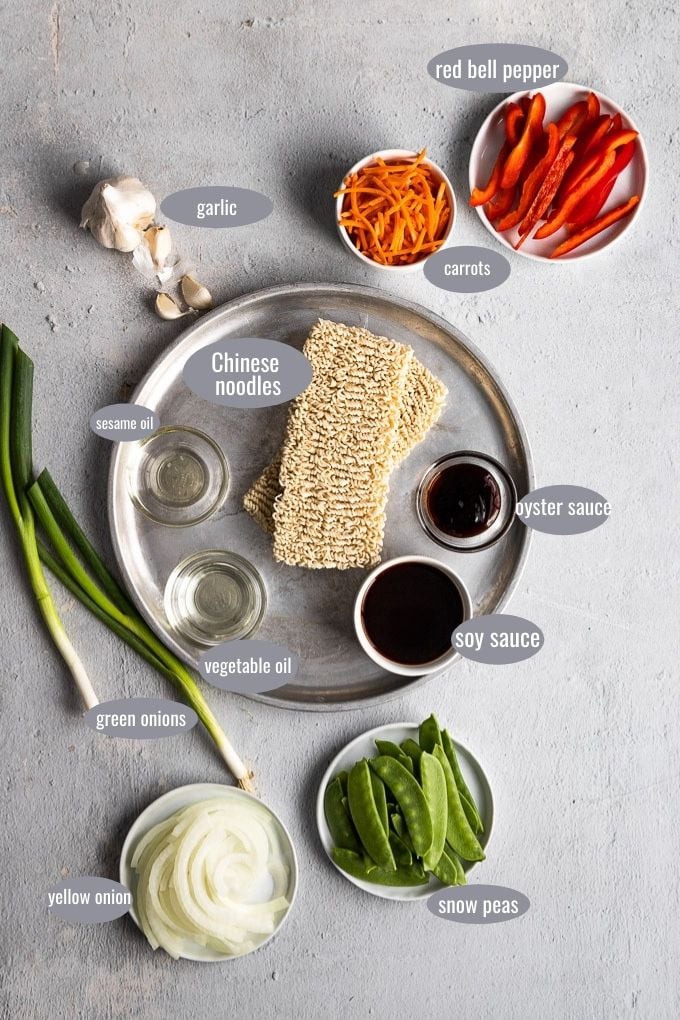
- Chinese Noodles – As mentioned above, we’ll be using egg noodles for this recipe. Just below I talk more about the specific noodles I use in this recipe, and how they differ from the thicker, traditional lo mein noodles.
- Yellow Onion – they get slightly caramelized and the thin slices weave their way through the noodles creating a luscious flavor and texture!
- Red Bell Pepper – a beautiful pop of color and crisp crunch.
- Snow Peas – color, texture, and oh so good for you.
- Carrots – you can julienne the carrots yourself or make it easy and buy them pre-shredded.
- Garlic – I feel like this is a no-brainer.
- The Sauce – lo mein is all about the sauce! This version uses 4 simple ingredients… keep reading for more info!
What kind of noodles are best for making lo mein at home?
I mentioned that the noodles are key to me. Remember, my nostalgic heart that fell in love with the unique thin noodles in lo mein all those years ago in the little restaurant we frequented?
For this lo mein recipe, I use store-bought dried Chinese egg noodles for ease, as I know I can always find them in the grocery store nearby. There are several other noodle options you can go with, however.
If you’re able to, you can find fresh egg noodles at a local Asian market and prepare them according to the package directions. These will generally be thicker than the variety I make this recipe with, and you’ll likely want to double the sauce if using thicker noodles.
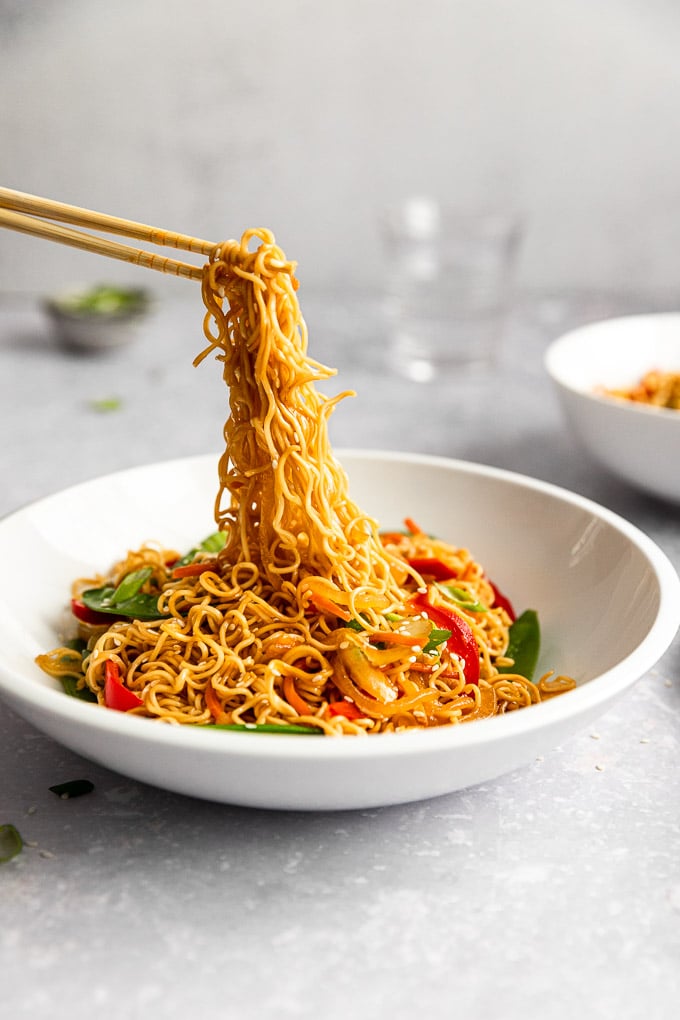
In an effort to keep things as easy as possible for you, we are using dried noodles (again, typically more of a chow mein thing) and then cooking them fully before tossing them with the other ingredients (lo mein there!).
Here is a list of the noodles I’ve had the best results with, for both their thickness and texture in the lo mein. Keep in mind, that these are thinner noodles.
- Kame Chinese Noodles (affiliate link) – I find these noodles to have the perfect width and texture. I used to find them at Whole Foods, but no longer can. I have found them at Hy-Vee in the Twin Cities, but you can check on their website to locate the product (not sponsored BTW).
- China Bowl Chinese Noodles (affiliate link) – I’ve also used other products labeled as Chinese noodles with good results, though the thickness can vary slightly. The ones in the link are in the ingredient photo and video; I found them at Whole Foods.
- Ramen Noodles – I find these are a good substitute if needed.
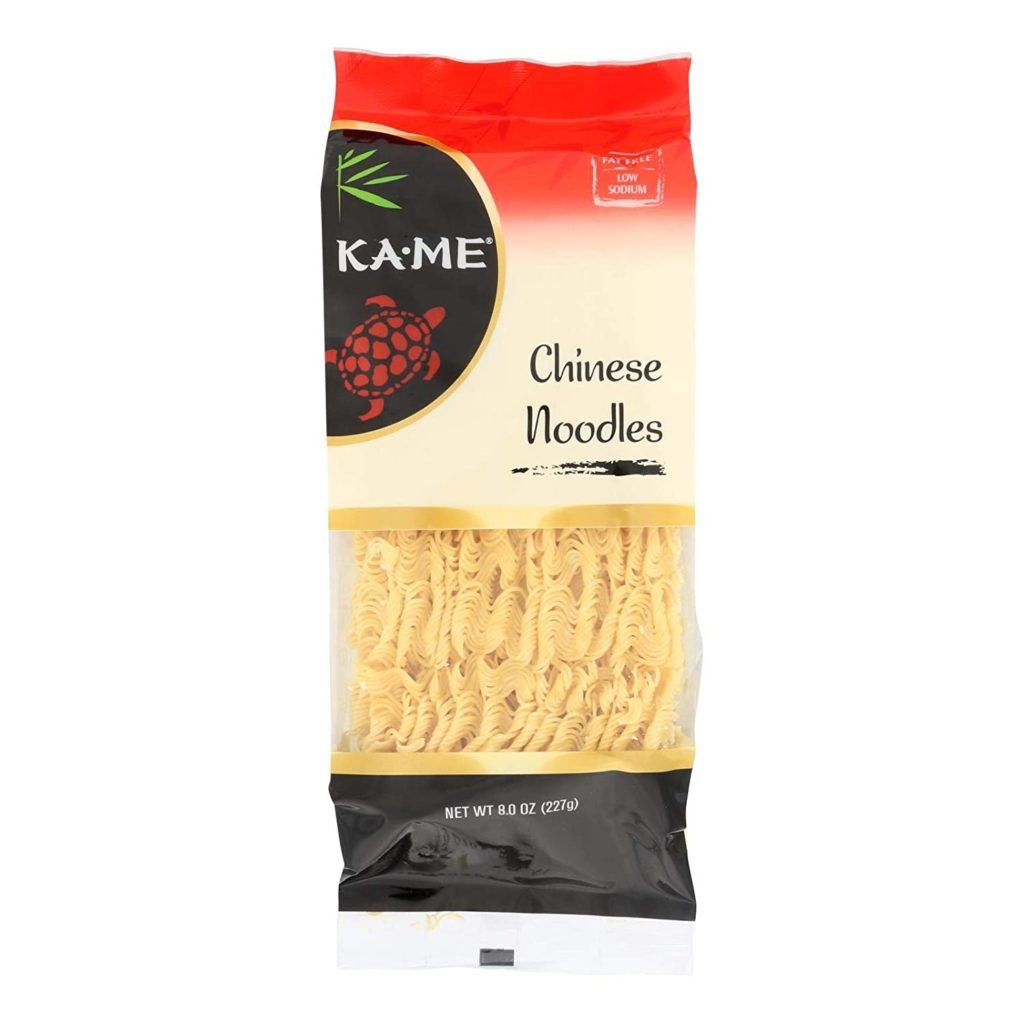
Kame Chinese Noodles
These noodles have the perfect width and texture for this lo mein recipe!
If you do prefer lo mein with a thicker noodle, look for noodles specifically labeled ‘lo mein noodles’ in the store or use fresh lo mein noodles if you can find them. In a pinch, you can also use spaghetti or linguine, cooked to al dente.
What is in this Lo Mein Sauce?
This sauce is super easy to make and uses pantry staples for Asian-inspired cooking.
- Oyster Sauce – full of umami flavor! It’s just slightly sweet and salty and adds complex flavor to the lo mein sauce. The addition of oyster sauce means this isn’t a vegetarian recipe, but rather pescatarian.
- To make this recipe completely vegetarian and vegan, use vegetarian (or vegan) friendly oyster sauce.
- Soy Sauce – the standard, and a must for the base of this sauce.
- Dark Soy Sauce – now, this is an ingredient you might not have on hand immediately, but it’s one that you’ll want if you like to make a lot of Asian-inspired food at home. Dark soy sauce is used for both flavor and to darken dishes. It has a slightly sweet aspect to it and is rich in flavor. If you don’t have any, you can substitute traditional soy sauce.
- Sesame Oil – adds an earthy, nutty flavor to the sauce, ever so slightly. A little bit of sesame oil goes a long way!
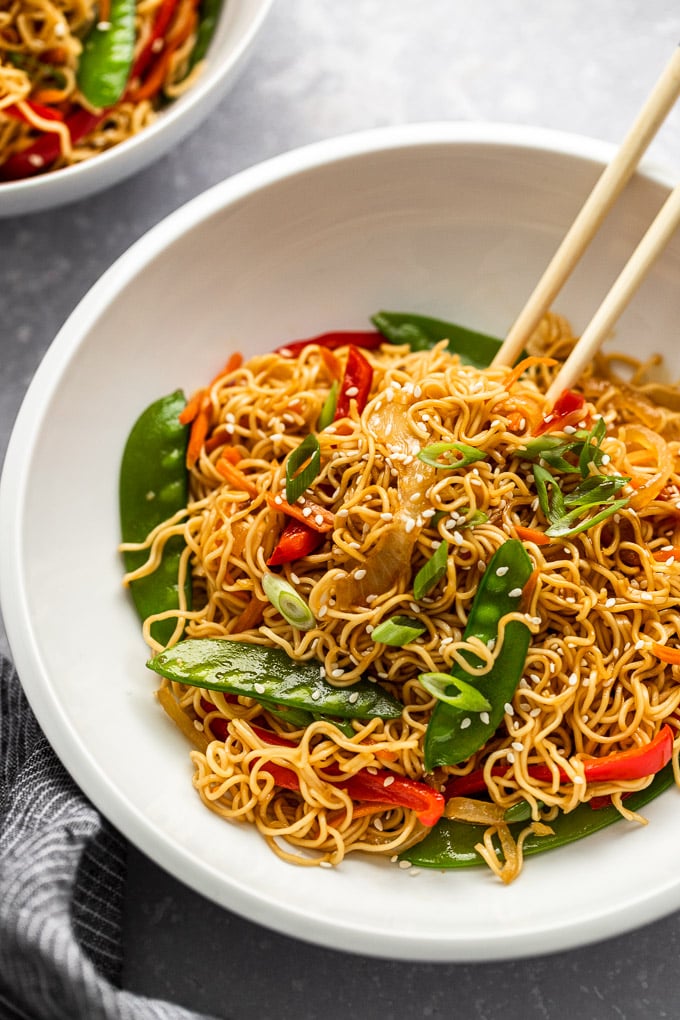
How to Cook Lo Mein Noodles
Are you ready to see how easy this recipe is? How in less than 30 minutes from start to finish you’ll have a savory, noodle-and-veggie-loaded dinner ready to devour? Yes, that includes prep time…it’s just 15 minutes to cook! As always, be sure to see the full recipe card below.
- Boil the noodles just under al dente. Because we’re also going to toss the noodles and sauce at the end of the cooking process, we don’t want them to be over-cooked. That’s no good, then they become mushy and soggy.
Boiling the noodles just under al dente ensures that they will keep their bite, and chewiness, and remain noodle-y (yes, a word in the FITK vocabulary!).
- Drain and rinse the noodles to stop the cooking process. They will reheat when they’re added to the vegetables at the end.
- Meanwhile, whisk the sauce together. This easy step can be done as the noodles cook, or while the veggies sauté.
- Then, it’s time to cook the veggies. Use a wok or a large skillet for the veggies as they need enough space to move around and cook evenly.
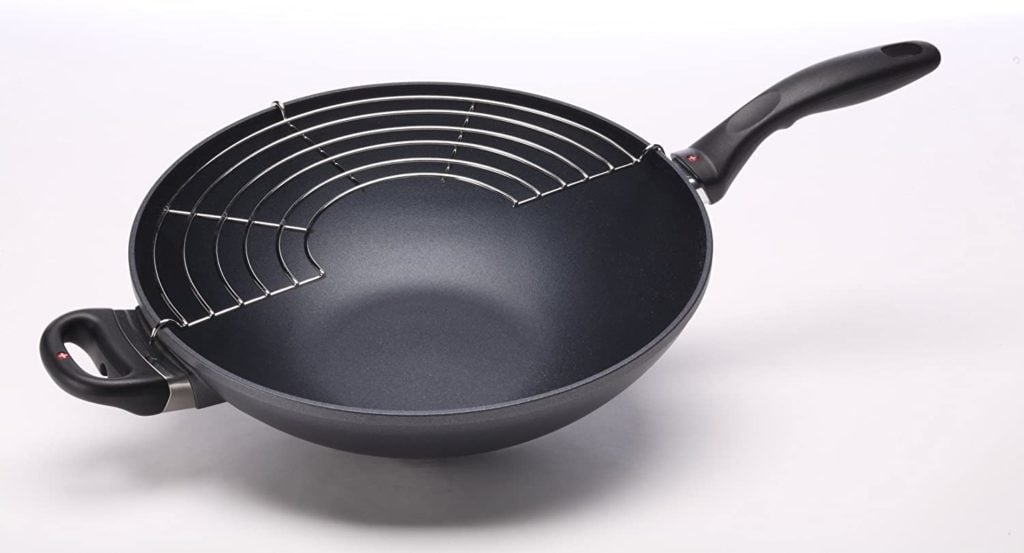
The Best Wok
If you love to make stir-fry for dinner, I highly recommend this wok. It’s the perfect size, large enough to hold all your veggies and noodles while cooking them evenly.
Photo credit: www.amazon.com
Stir Fry the Vegetables
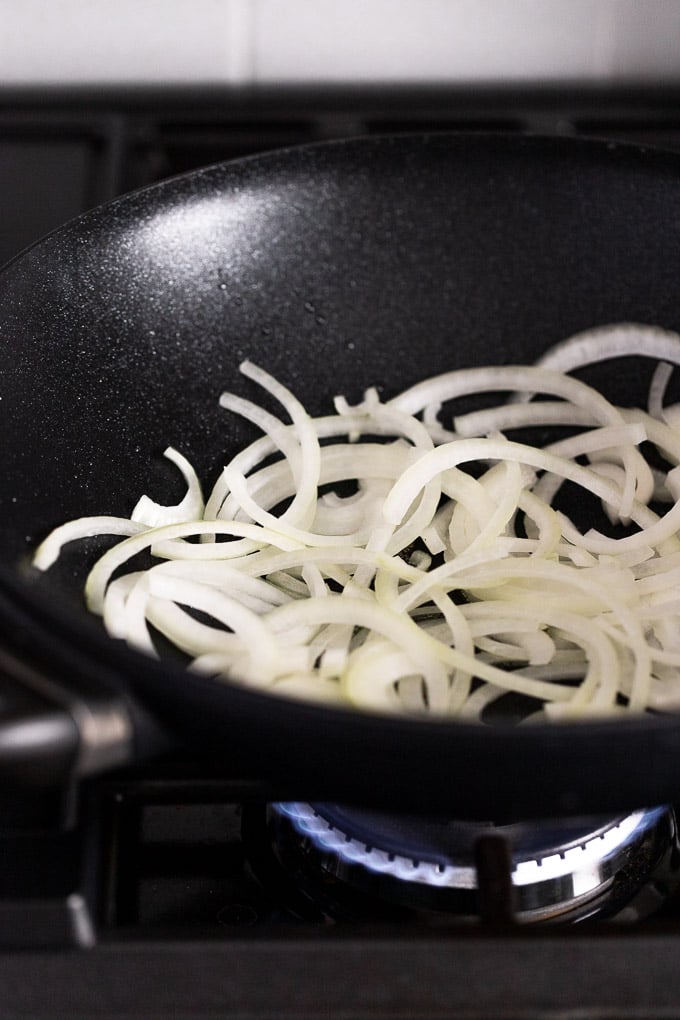
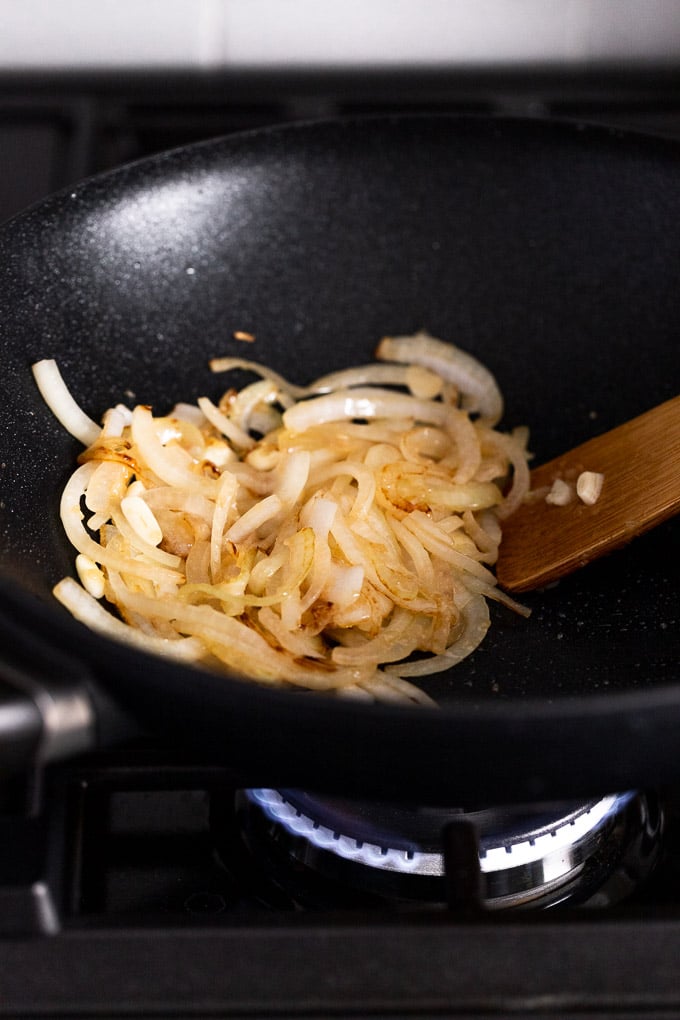
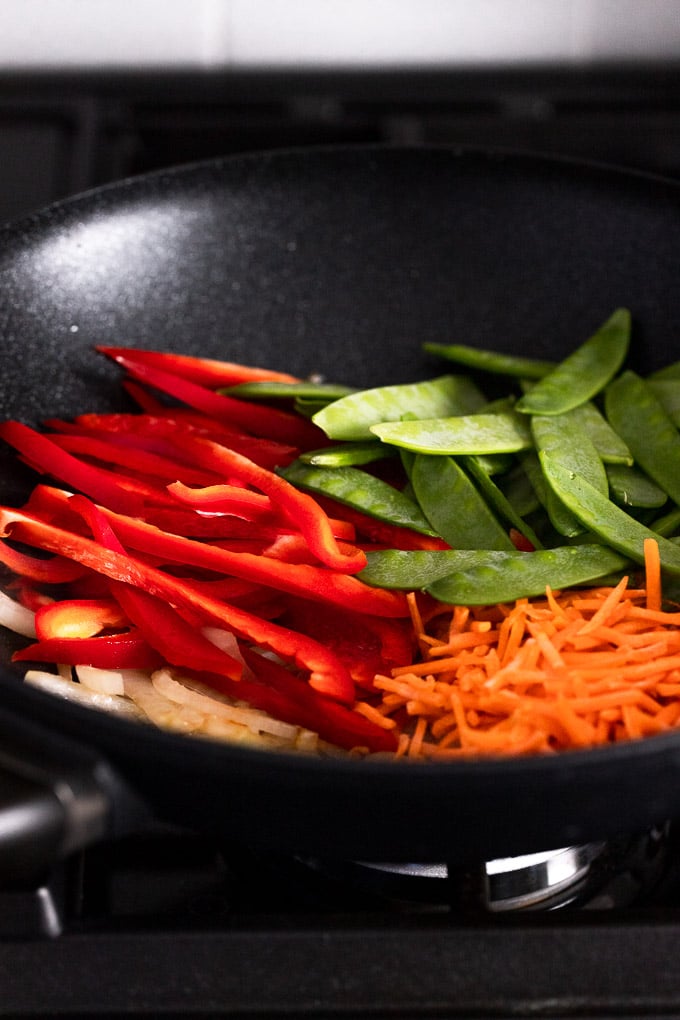
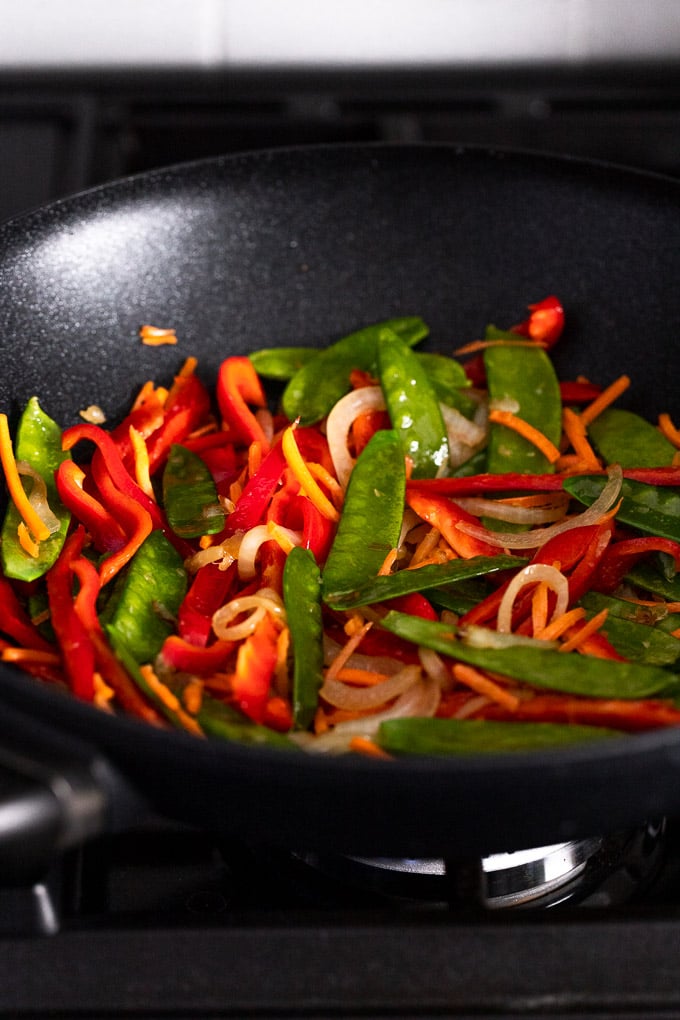
- For the vegetables, start with the onion slices. The onion adds the first layer of flavor, and it is going to become slightly caramelized resulting in a slightly sweet, rich flavor.
- Then, once the onion is tender, add the garlic. And if you’re here then you know that we never skimp on the garlic. It’s sliced in this recipe because it’s 100% delicious to get a slice of garlic in a bite. You can also mince or finely chop it if preferred.
- Next, add the red bell pepper, snow peas, and carrots to the skillet. These veggies are all pretty crunchy, so they need a minute to soften up. They’ll sauté as the flavor of the onion and garlic meld together, too.
- Now that the vegetables are almost ready, it’s time to add the noodles to the wok or skillet. Along with the noodles goes the sauce. Toss it all together, and continue to cook to heat the noodles and sauce together.
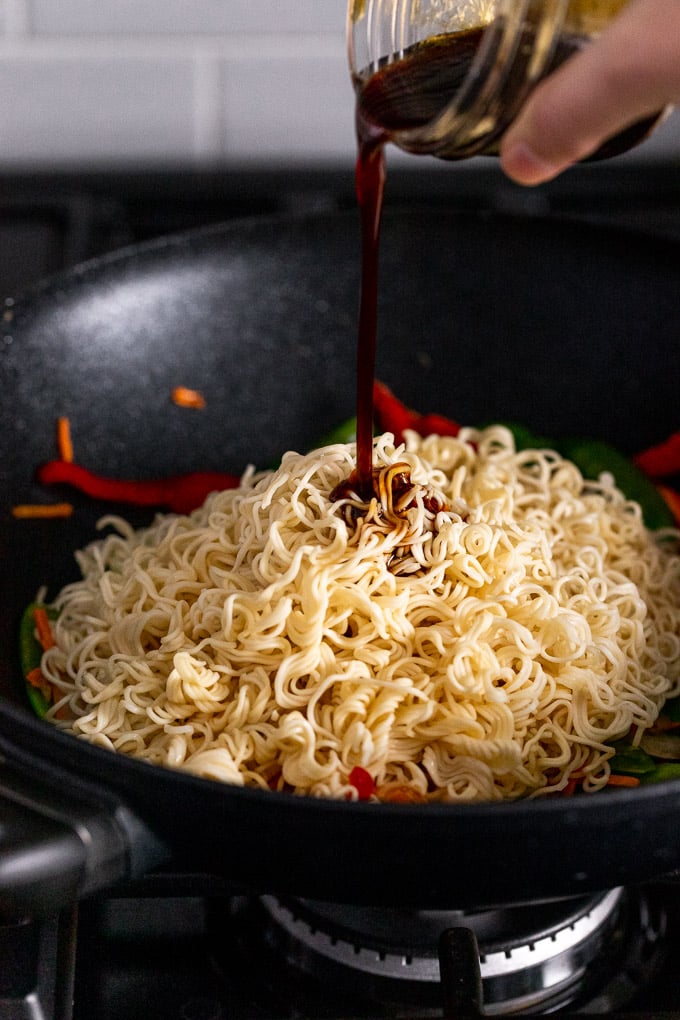
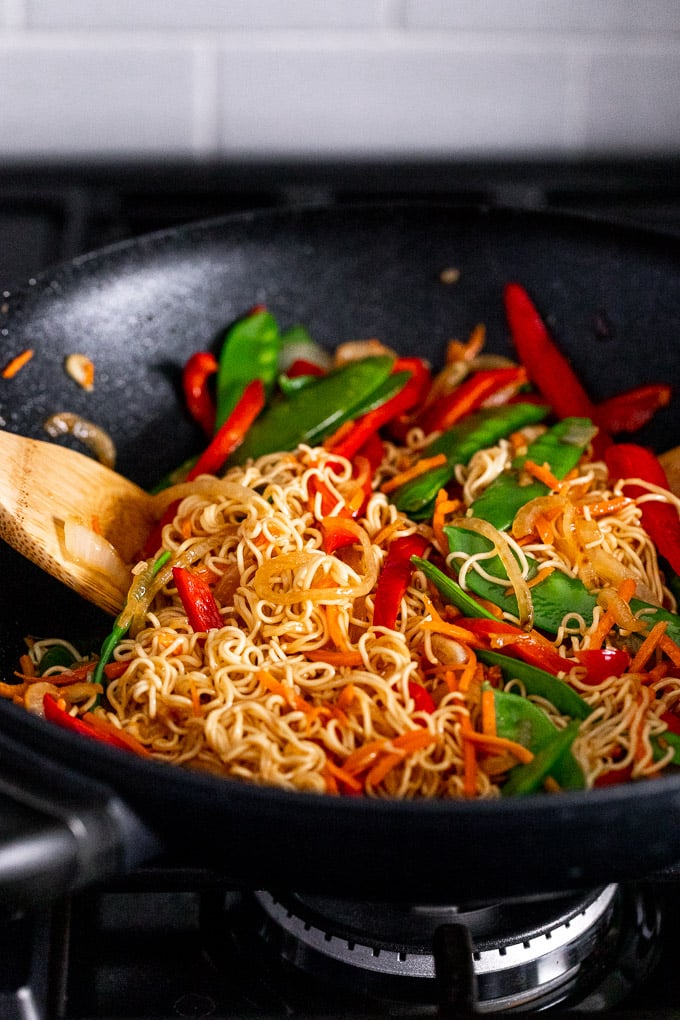
Now for the best part — eating! Vegetable Lo Mein is absolutely delicious served with scallions and a few sesame seeds for texture. It’s also completely acceptable if you don’t have any time to wait and just need to dig in. I get it!
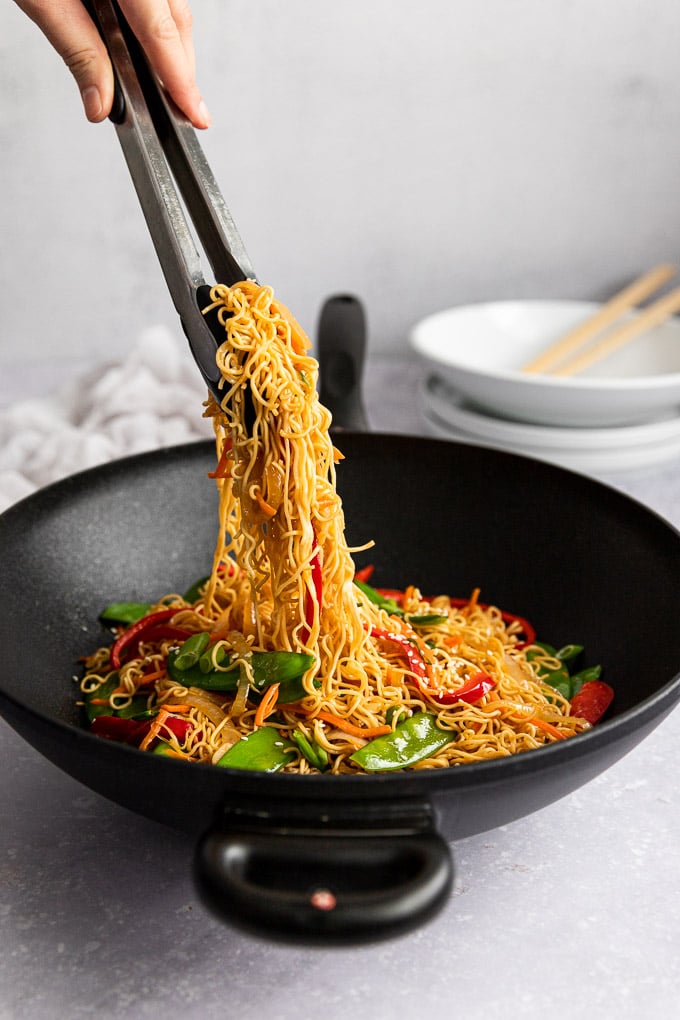
Is Vegetable Lo Mein Vegan?
Yes, you can easily make this veggie lo mein recipe vegetarian or vegan with one simple ingredient swap.
Instead of oyster sauce, which is made with oysters, use a vegan oyster sauce substitute, generally made with mushrooms instead. It gives the same umami flavor that the oyster sauce provides but is made without seafood.
More Frequently Asked Questions
Absolutely! Thinly slice a chicken breast and cook it in a little oil in your wok or saucepan. Then remove it from the pan and set it aside while you cook the vegetables. Add it back in with the noodles and sauce to reheat as needed. This method will also work well with shrimp or cubed pork. Obviously, it won’t be vegetarian or vegan if you add meat; add in tofu to keep it plant-based.
The options are really endless here, and you can customize the vegetables in this recipe so easily. Mushrooms would be excellent – cook them with the onions and allow the moisture to evaporate out of them before adding the remaining veggies. Bean sprouts would be a great crunchy addition. Bok choy is loaded with nutrients and would be excellent as well (add it with the bell pepper, etc.). Broccoli is another favorite!
Yes, in a pinch you can substitute spaghetti or linguine noodles in this recipe. I would recommend doubling the sauce in this case, too.
You can use regular soy sauce in its place.
Excellent! As with takeout, these noodles soak in the flavor and reheat great both in the microwave or on the stovetop the next day. If they have seemed to dry out a little, toss with a splash of soy sauce to liven them right back up.
If using thicker noodles, I would recommend doubling the sauce to make sure the dish is still saucy enough.
Standard lo mein noodles are not gluten-free, as they are made with wheat. You can try to make the recipe with rice noodles for a gluten-free option, however, I haven’t tried it myself. Let us know if you give it a try!
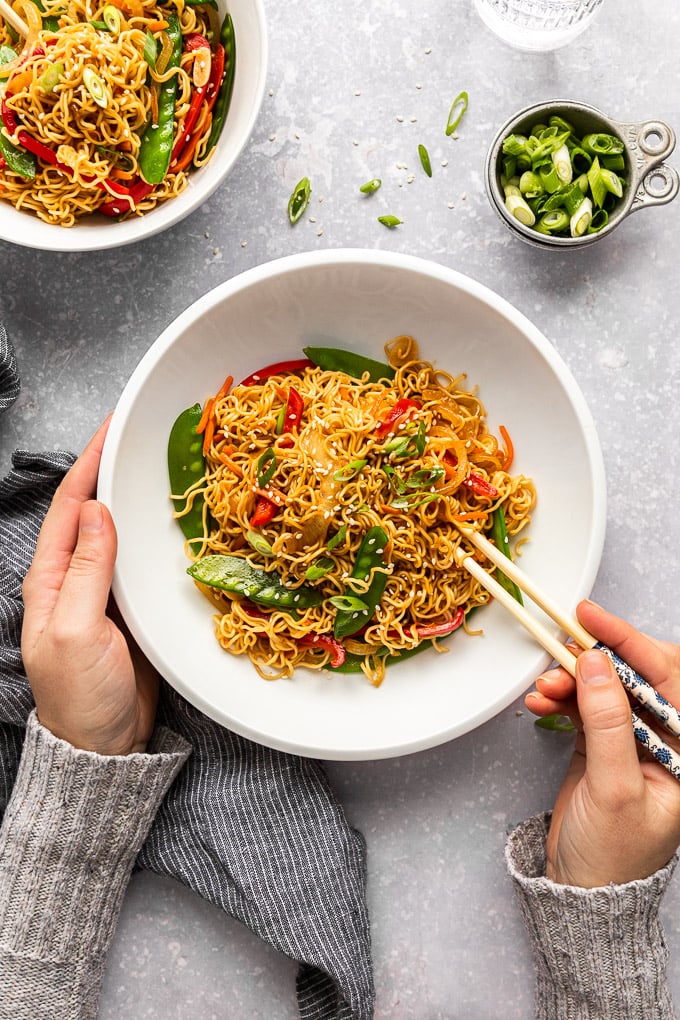
More Quick & Easy Asian-Inspired Recipes
- Cauliflower Teriyaki Lettuce Wraps
- Pineapple Fried Rice
- Curried Shrimp Fried Rice
- Cheesy Pepper Jelly Wonton Cups
Did you make this recipe? Please leave a star rating and review in the form below. I appreciate your feedback, and it helps others, too!
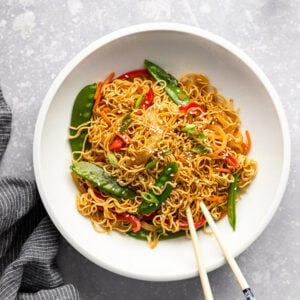
Get the Recipe Quick Homemade Vegetable Lo Mein (Vegan Option)
Ingredients
Lo Mein Sauce
- 1 Tablespoon oyster sauce, vegan, if needed
- 1/2 teaspoon sesame oil
- 1 Tablespoon dark soy sauce
- 1 Tablespoon regular soy sauce
Lo Mein Ingredients
- 4 ounces Chinese noodles, generally 1/2 package
- 1 1/2 Tablespoon vegetable oil, or another neutral oil
- 1/2 medium yellow onion, thinly sliced (~ 1 cup)
- 2 garlic cloves, thinly sliced
- 1 cup carrots, shredded or julienned (2 medium)
- 1 red bell pepper, thinly sliced
- 3-4 ounces snow peas
- Optional: sliced scallions for garnish
Equipment
Instructions
- In a small bowl, make the sauce by whisking together the oyster sauce, sesame oil, and soy sauces. Set aside.1 Tablespoon oyster sauce, 1/2 teaspoon sesame oil, 1 Tablespoon dark soy sauce, 1 Tablespoon regular soy sauce
- Bring a large pot of water to a boil. Cook Chinese noodles for 1-2 minutes (see package directions and cook 1-2 minutes less than the recommended cooking time to ensure they don’t overcook later). As they boil, stir to unfold the noodles. Drain, rinse in cold water and set aside.4 ounces Chinese noodles
- In a wok or large skillet, heat vegetable oil over medium heat. Add onion slices and cook for 4-5 minutes, until tender. Add garlic, continuing to stir for 1 minute as it becomes fragrant. Add carrots, bell pepper, and snow peas. Cook for 4-5 minutes until tender.1 1/2 Tablespoon vegetable oil, 1/2 medium yellow onion, 2 garlic cloves, 1 cup carrots, 1 red bell pepper, 3-4 ounces snow peas
- Add the par-boiled noodles to the wok and pour in the sauce, stirring to coat. Continue to cook for 1-2 additional minutes until noodles are cooked through and sauce is distributed evenly. Serve immediately with scallions as desired.Optional: sliced scallions for garnish
Notes
- To add a protein: cook the desired protein (thinly sliced chicken or shrimp work best) in the wok/skillet first by adding a little oil, cooking through, and removing from pan until ready to add back in with the noodles at the end of the recipe.
- Serving Size: This recipe makes two large serves; you can easily double it. If serving with additional items, you can stretch it to 4 servings.
- To make vegetarian or vegan: use vegetarian/vegan oyster sauce.
- Dark Soy Sauce: you can substitute regular soy sauce if needed, or create a substitute.
This recipe is part of our Date Night Recipes to Love roundup. Check it out!


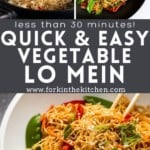



These noodles look INSANE! Would you believe I still don’t have a wok? I definitely need to get on the wok train asap!
Thanks, Liz! I think woks are one of those things you don’t realize how much of a difference they make until you actually have one – I LOVE it!
This recipe is PERFECTION!! Made it tonight for the family with a few modifications — added chicken (cooked first, as you indicate), added celery just because I had it, and a little bit of Chili Sauce for some heat and we gobbled this up!! Super super delicious! I will make this again and again!!!!
I’m so glad you loved it! Thanks for sharing! 🙂
This lo mein looks amazing! I’ll be making it for dinner tonight. Thanks for sharing the recipe.
Happy Monday
Hope you enjoy! 🙂
Yummmm so delicious so easy
Definately making this one again!!!
Thanks for sharing!!!
It’s one of my family’s favorites, too! Glad you enjoyed!! 🙂
What kind of noodles are these? Tried looking at the grocery store and had no idea which ones to get lol
They’re the Kame brand’s “Chinese Noodles” – I find them in the Asian/International section. They’re linked in the recipe card and blog post for a photo reference (or to buy in bulk on Amazon ;)).
They are also called egg noodles.
You’ll just want to be sure you want the thin ones for this recipe. Obviously if you prefer thick, feel free to use! 🙂
This recipe is SO easy to make, packed full of veggies, and most importantly, DELICIOUS!! We doubled the recipe for 4 so that we’d have lots of leftovers and I’m so glad we did. We’ll be adding this into our rotation of favorite recipes and cannot wait to try it again–maybe adding some chili paste like Becca suggested for extra kick, and hopefully next time with a wok. 😉 Thanks for this gem!
Doubling the recipe is absolutely the way to go 🙂 can’t beat the leftovers!
Always delicious, easy to make, and pretty good for you! Definitely a go-to recipe.
So glad to hear! Thanks, Matt!
I asked my sister for a vegetarian recommendation and she recommended this blog. This recipe was delicious and we loved it!!! Such an easy dinner that we will for sure make again.
I’m so glad to hear! Thanks so much, Marni!!
Way too salty. Otherwise ok. Wouldn’t put so much in the sauce recipe nxt time.
Thanks for the feedback, Jane!
Hi Becca. This is a great recipe! My husband calls it Super Duper Ramen because those are the only noodles I had on hand. I’m a big fan or quick, easy Asian-inspired recipes that can make at home, so thank you for this one.
Ruth
I’m so glad to hear, Ruth! Love your husband’s name for it too! 🙂 Thanks so much for your comment.
The sauce is the star here, delicious!
Thanks, Kent! I’m glad you enjoyed!
I doubled the sauce and added some mushrooms. Delicious! Another forkinthekitchen recipe added to my favorites board 💕
Yay, I’m so glad to hear! I bet mushrooms were delicious in it!